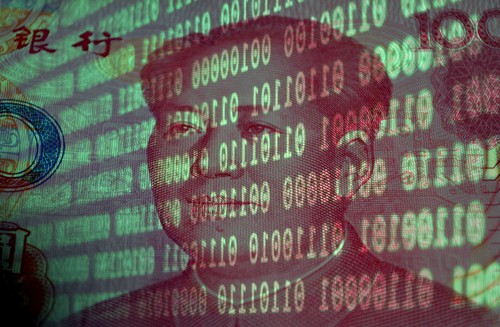In this issue
- DeFi protocol Yam takes flight, then plunges back to earth
- Coinbase offers loans with bitcoin as collateral
- U.S. Fed announces CBDC collaboration with MIT, while Postal Service explores blockchain-assisted voting
- In China: DCEP testing expands to Beijing and finance centers; Huobi launches Global DeFi Alliance
- VC spotlight: crypto custody in Hong Kong
From the Editor’s Desk
Dear Reader,
The race is on.
Federal Reserve Governor Lael Brainard shared that the U.S. Federal Reserve is now working with MIT in a multi-year collaboration, to determine how America’s Central Bank might one day be using, deploying and integrating a digital U.S. dollar into global currency markets. They listened.
As the pressure mounted from industry leaders, including Digital Dollar Foundation and Accenture’s “Digital Dollar Project,” whose whole raison d’etre is how to help America think about implementing today’s technology to create a U.S. central bank digital currency to address modern needs and challenges (now more timely than ever amidst geopolitical tensions and Covid-19), the Fed listened. After all, it was only a few short weeks ago when Federal Reserve Chairman Jay Powell responded to questions about his thinking regarding a central bank-backed digital dollar: “We need to understand it first and best.” The Fed moved quickly from “understand” to now “do.”
But China has a six-year lead. As the country expands its pilot phase of its digital RMB (DCEP — Digital Currency Electronic Payment), Forkast.News notes that more and more banks and individuals are testing it out in real-life, day-to-day business and personal transactions. China’s central bank, PBOC, has been working behind-the-scenes for a while to reach this day. It sped up after Facebook’s announcement of Libra last year, and you can be sure that its pace has intensified even more as U.S.-China tensions thicken. We may be entering a bifurcation of the global economic system, with technology protocols defining the boundaries. But as we’ve seen time and time again, innovation winners aren’t always determined by who started first… or even sometimes, who gets there first. It depends on teams, ingenuity, creativity and inspiration. And if there’s one thing we know, the nurturing of innovation is the most important aspect of it all.
Until the next time,
Angie Lau,
Founder and Editor-in-Chief
1. YAM skyrockets before crashing back to earth

By the numbers: YAM — over 5,000% increase in Google search volume.
Decentralized finance (DeFi) yield farming experiment Yam protocol became an overnight sensation when it garnered US$400 million worth of tokens on the first day of its launch. But in the next 24 hours, YAM’s price crashed from almost US$160 to zero. Yam launched without a code audit and only subsequently discovered a code error that was causing an excessive minting of YAM.
- Yam protocol requested support from the DeFi community to lock up 160,000 YAM to regain control of the network. This cry for help received support from major players such as CoinGecko and Synthetix, but to no avail as the token plummeted back to earth.
- Despite the project’s failure, Yam has been able to receive community support rather than being labeled a “scam.”
- Yam protocol’s co-founder Brock Elmore (@brockjelmore): “i’m sorry everyone. i’ve failed. thank you for the insane support today. i’m sick with grief”
- MakerDAO head of smart contracts Mariano Conti (@nanexcool): “These were the most epic couple of days in DeFi history. I stand with you”
Forkast.Insights | What does it mean?
Here is the bug in Yam’s code that cost the new protocol the whole gig:
totalSupply = initSupply.mul(yamsScalingFactor)
When it should have been:
totalSupply = initSupply.mul(yamsScalingFactor).div(BASE)
Before Yam’s crash and burn, Yam’s developers were upfront that the protocol’s design hadn’t been code-audited. But a flood of investment dollars came its way anyway.
For a minute, you’d be forgiven if you thought we were back in 2017. A more peaceful time, a pre-Covid time, when a flashy website and a white paper were all you needed to raise a fortune with an Initial Coin Offering (ICO). This Wild West era of the ICO was one where funds were raised first and questions got asked later.
Fast forward to 2020 and we can swap out ICO for DeFi. What’s the difference? DeFi projects are attracting institutional-grade investment dollars. Recall that Compound, the token that seemed to be the blockbuster token hit of the summer until it wasn’t, had prominent American venture capital firm Andreessen Horowitz money behind it.
Investors, both retail and institutional, seem so desperate to unlock value from the tokenized economy that they are throwing money around just to see what will stick. Like a brand-new, under-tested protocol that launched via a Medium blog post.
Despite its promises in the developing world, in developed economies, DeFi isn’t exactly proving to be a great liberator from the traditional financial system, but rather just another way for traders to extract more capital. Loans collateralized by stablecoins fuel crypto derivatives trading; the profits from that go back in for buying more stablecoins or tokens, which, in turn, can be traded for some more. There’s a lot of money moving around and being made here, but is there actual value being created? There are certainly benefits of unlocking more liquidity for traders, but this strays far away from the original ideas of DeFi — creating alternatives to the financial system for the unbanked. Now, it’s just another tool in the toolkit of traders.
A recent CoinDesk column by William Foxley has brought light to the term DeFi “Degen”: a “degenerate” that knows their punting around of DeFi tokens is making money but not creating value, yet doesn’t care. This is an apt word to describe the moment we are in, a moment that doesn’t do the professional image of crypto finance much good.
2. Coinbase offers crypto loans

By the numbers: Coinbase — 2,450% increase in Google search volume.
Coinbase users can now borrow cash from the exchange using bitcoin as collateral. The borrow feature is set to go live in 17 eligible U.S. states this autumn, where users can join a waitlist to borrow up to 30% of their bitcoin holdings.
- The loan ceiling is set at US$20,000 with an 8% annual interest rate. Coinbase says it reserves the right to “review” the rate over time.
- The exchange is also boasting loans without credit checks.
Forkast.Insights | What does it mean?
As recently reported on Forkast.News, the crypto-loan industry — which is only loosely regulated — has been growing by leaps and bounds, with collateral deposited now exceeding over US$13 billion. Even during the worst days of market volatility back in March, crypto debt in the first three months this year grew by 44%, while assets under management grew by 75%.
The vast majority of the demand for crypto loans comes from liquidity requirements for DeFi. Taking money out of the crypto market is almost always a taxable event, so it makes more sense to keep money flowing through the system if you intend to reinvest it.
Coinbase sees the opportunity. When it comes to legitimacy, the industry operates on a spectrum: there are plenty of illegitimate providers, but also legit ones too. Coinbase, with its size, weight and legitimacy can cut through the noise and is in a good position to take over a chunk of this market. With its planned IPO, Coinbase’s entry into the crypto loans market will also no doubt draw the attention of regulators. It would not be surprising if moves by major players like this will result in a next generation of regulation coming down the pipe.
3. Is the U.S. government finally embracing blockchain?

By the numbers: digital dollar — 5,000 % increase in Google search volume.
Federal Reserve Governor Lael Brainard discussed plans for a digital dollar during the Federal Reserve Bank of San Francisco’s Innovation Office Hours last week, noting that the Fed is now working with Massachusetts Institute of Technology (MIT) researchers in a multiyear collaboration to “build and test a hypothetical digital currency oriented to central bank uses.”
- “Given the dollar’s important role, it is essential that the Federal Reserve remain on the frontier of research and policy developments regarding CBDCs (central bank digital currencies),” she said in the webcast. “Like other central banks, we are continuing to assess the opportunities and challenges of, as well as the use cases for, a CBDC, as a complement to cash and other payment options.”
- Brainard also mentioned that Bitcoin’s growing profile and the rise of stablecoins such as Facebook’s Libra have increased interest in a U.S. CBDC. “Moreover, China has moved ahead rapidly on its version of a CBDC,” she said.
- “The introduction of Bitcoin and the subsequent emergence of stablecoins with potentially global reach, such as Facebook’s Libra, have raised fundamental questions about legal and regulatory safeguards, financial stability, and the role of currency in society,” Brainard added. “This prospect has intensified calls for CBDCs to maintain the sovereign currency as the anchor of the nation’s payment systems.”
Forkast.Insights | What does it mean?
The next generation of liquidity is going to be issued via digital ledgers. Every central banker — many of whom want a way to increase money supply without the damaging impact of inflation — knows this, which is why you can find parallel efforts to research and produce CBDCs around the world, from China to Southeast Asia, Europe and Canada.
In the U.S., the push for a digital dollar, until recently, remained largely a private sector effort. But perhaps China’s growing lead in the global CBDC race, or the growing need in the U.S. to distribute cash aid to its Covid-ravaged masses more efficiently has spurred American central bankers to step up and take greater action.
Of course, putting a software layer on top of a nation’s money — whether it is the U.S. dollar or the RMB — isn’t going to change the fundamentals of the currency. The market will still dictate a currency’s value. But digitization will make money slightly more liquid. Just enough for it to be a viable contender for cross-border settlement, when using another currency isn’t feasible or not allowed, as in the case of sanctions.
As China forges ahead with its new digital currency, other western nations are also developing their own versions of CBDCs that could challenge the USD-denominated world order. A successful euro-CBDC could be an effective challenger, while a pound-CBDC could bring some post-Brexit liquidity back to the sterling.
Finally, there’s also the issue of sovereignty. Institutional trust of Facebook is at an all-time low. In the meanwhile, Facebook is elbowing into the digital currency space by preparing to launch Libra, its own digital currency. Is Facebook the institution that the Fed and other U.S. policymakers want as a major player in the realm of America’s digital money supply?

By the numbers: USPS — 5,000 % increase in Google search volume.
As President Donald Trump rages against America’s mail-in voting system and calls it “catastrophic,” the United States Postal Service has been quietly exploring blockchain technology to assist with elections. USPS filed a patent for a blockchain-based mail-in voting system back in February but only recently announced it to the public.
- The “Secure Voting System” proposes that registered voters will receive codes in the mail to confirm their identity and ballot information. Identification of voters and votes will be separated to ensure anonymity.
- A USPS spokesperson told Business Insider that the technology described by the pending patent application will not be used in the upcoming November election.
Forkast.Insights | What does it mean?
Hypothetically speaking, blockchain technology may be the perfect tool for an election in a pandemic year where people are likely not going to be able to get to the polls, mail-in voting may not be logistically feasible, and outside interference is expected. A blockchain hash tied to a key could be a confirmed, immutable record of a vote. Transparent, but still protective of the secrecy of the vote while preventing double-counting.
But the devil is in the implementation. Voatz, which infamously was deployed during the Democratic Party primary earlier this year, was also blockchain-based and turned out to be a miserable failure. This is such a concern, in fact, that the American Association for the Advancement of Science’s Center for Scientific Evidence in Public Issues has written a lengthy open letter to lawmakers and other stakeholders outlining the dangers of internet-based voting, including risks that would not be remediated with blockchain.
All in all, blockchain-assisted voting is an interesting thought and technical experiment. Firms and other organizations will often patent their research, even at its earliest stages, but that doesn’t mean that the idea is anywhere close to becoming a reality or that the invention will work as intended.
4. In China: e-RMB testing expands to Beijing; Huobi launches DeFi alliance

China has greatly expanded the testing of its new digital RMB — also called Digital Currency, Electronic Payment (DCEP) — to more Chinese cities, including the nation’s capital and major financial centers.
- China’s Ministry of Commerce has announced that the DCEP will be further tested in three major regions, from the north to the south of the nation, covering 28 cities.
- The new DCEP testing grounds include the Yangtze River Delta, which covers Shanghai and the three neighbouring provinces of Jiangsu, Zhejiang and Anhui, the “economic circle” around Beijing, and the Hong Kong-Macau-Guangdong Greater Bay Area.
- Bai Hexiang, the president of People’s Bank of China’s Guangzhou branch, told Southern Daily, a mouthpiece of Guangzhou provincial government one week before the announcement, that financial institutions and other companies in the region — especially retail businesses and those focusing on the “sharing” economy — should get involved in DCEP’s development and help create more uses cases in the Greater Bay Area for the new digital RMB.
Forkast.Insights | What does it mean?
China’s DCEP seems to be weeks away from officially launching with extensive testing underway in the country’s major economic hubs. The current flaw in the People’s Bank of China’s testing strategy is marketing DCEP as a competitor to WeChat Pay and AliPay.
Granted, one of the reasons behind the PBOC’s push to develop DCEP is to wrestle some of the control of the money supply away from Tencent and Alibaba. The success of these mobile payment platforms means a lot of capital is locked in their private coffers, and central bank-led monetary policy in that environment wouldn’t have the same effect. But practically speaking, the better use case for DCEP might be as a challenger to the U.S.-led SWIFT, not as a clone of WeChat Pay or AliPay.

Huobi DeFi Labs announced the launch of Global DeFi Alliance, a consortium with such DeFi giants as MakerDAO and Compound, to expand the DeFi ecosystem and strengthen cross-border collaborations.
- This follows the recent establishment of Huobi DeFi Labs — Huobi Group’s new decentralized finance division aimed at bolstering DeFi research, development and incubation.
- The alliance aims to connect the centralized and decentralized finance communities as well as bridge the DeFi ecosystems of the East and the West. As there was no such alliance focused on DeFi in Asia before, Huobi might have the first-mover advantage.
Forkast.Insights | What does it mean?
Huobi recently announced that it intends to offer institutional grade custodian services as investors seek new, alternative assets. If DeFi can mature from a collection of pump-and-dump schemes to being a proper alternative to building liquidity, institutional investors are going to want to have access, and platforms like this is how it will be done.
Although institutional-grade investors are seeking crypto currency and digital assets to diversify their portfolios, DeFi isn’t at that point yet. However, efforts by Huobi to help professionalize and mature this space can certainly help.
5. Funding spotlight: crypto custody in Hong Kong
Hex Trust — seed, Hong Kong SAR, undisclosed
Hex Trust, a cryptocurrency custody holder based in Hong Kong, received an undisclosed amount of funding in order to “integrate additional services, onboard new clients and expand geographically” with its Hex Safe custody platform. The funds were raised from Kenetic Capital, a Hong Kong-based trading, venture capital and digital asset services firm. As part of the deal, Kenetic co-founder and managing partner Jehan Chu became a board member of Hex Trust. Chu is a current co-chairman of the Fintech Association of Hong Kong and a founding member of the Bitcoin Association of Hong Kong.
Forkast.Insights | What does it mean?
As Hong Kong opened its doors to allowing institutional custody of blockchain, Hex Trust was one of the first to develop a regulatory-compliant custody platform that both met the needs of investors and stayed inside the framework developed by the region’s regulators.
This funding round is a testament to the thesis that crypto is becoming an institutional-grade investment product that’s ready for prime time. As this turbulent year enters its final quarter, and market gyrations are expected to increase with equities prices crashing back down to reality, investors are going to seek shelter somewhere. And that is likely to be crypto and digital assets, which could only bolster the need for custodian firms like Hex Trust.




